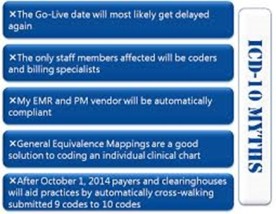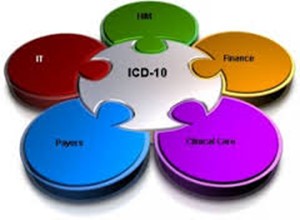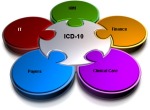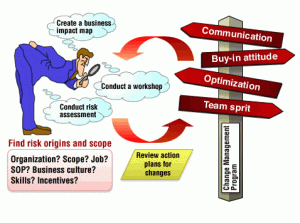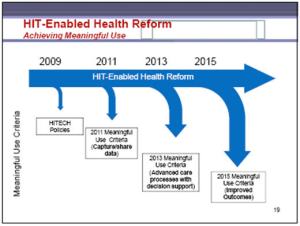In this first article, l discuss Process Improvement and Document Improvement as it pertains to Computer Assisted Coding. Follow-up articles will touch on Interfacing, ADT’s, abstractor and encoder considerations, as well as networking and impacts to the EHR.
The past few years I have had the chance to work with numerous health systems, either directly or in advisory capacities. In many we were brought in to build, lead and oversee their large ICD-10 Programs and most include Computer Assisted Coding Programs. I have worked often with both 3M and Optum solutions and think both solutions have their merits and faults. Both have the potential to provide robust value, but, I have yet to see where the product alone, without significant organizational improvements, performed to the estimated productivity standards or met the quality thresholds.
My firm has been called repeatedly by providers to assist with improving the productivity and performance of their CAC systems as well as manage new implementations. They are facing major implementation, budget and timeline challenges they weren’t prepared for. Most had no idea of the significant impact on interfacing both from the number of systems, the number of interface modifications, encoder-abstractor upgrades and modifications.
Comparatively Speaking, organizations that have one abstractor, encoder, EHR, etc… will find that their CAC System generally performs well. However, organizations with more than 2 abstractors and a disparate environment will experience implementation and performance difficulties to the point of eliminating any productivity gains.
There are things that could be identified early but aren’t. A CAC solution is somewhat new to most. Organizations often don’t know the questions to ask or can identify the behind the scenes challenges when they are in the early phases of their implementations. The vendors do a poor job overall of guiding the providers to an optimal performance state.
Providers are given the impression that they implement the product and the miracle of auto-suggested coding occurs. They see a hefty implementation cost from the vendor and think it should come ready-to-go with vendor direction and a few internal resources. Unfortunately, this couldn’t be further from reality. Executives don’t realize that to achieve the productivity standards and quality coding they’ve been promised, there needs to be significant effort in the following areas, before you can expect success with CAC:
- Process Improvement

- Document Mapping & Improvement (Document & Data Quality)
- Interfacing
- ADT data normalization
- Networking (capacity)
- EHR Impact
CAC IS an Enterprise System
Most healthcare organizations who are implementing CAC are learning that it is not like other departmental-based systems. Computer Assisted Coding is an enterprise system of integrated modules and takes input from numerous upstream systems. It can be a massive resource, network and interface drain and is further complicated with the implementation of Citrix. It is important to recognize that, with the number of foreign system interfaces, document types, formats and other configurable components, the scope of CAC can be compared to that of an HIS (EHR) system and needs similar levels of effort. It impacts clinical, patient access, revenue cycle, ancillary, inpatient and outpatient. Some even incorporate physician billing.
Two primary factors go into a successful CAC solution:
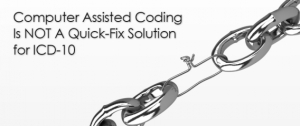 Process Improvement
Process Improvement
Most healthcare organizations have not made significant improvements to their Patient Access, HIM and Revenue Cycle policies and procedures in many years. Add to that the number of mergers and acquisitions, you now have large organizations with extremely disparate environments, systems and teams.
New systems are implemented and their workflows are set on top of old policies and procedures (originally designed for manual or outdated legacy systems or tools) which are wrought with inefficiencies and lack automation. When running a high volume of business with the level of increase in specificity (which is the case with ICD-10), the more manual touch points you have or the points between disparate technology and systems, the higher the probability for breakdowns, bottlenecks and issues.
** NOTE: Large health systems and IDN’s need to carefully consider their disparate nature and understand that for CAC to successfully achieve the goals, especially in an enterprise instance, they will need to expend time and effort to improve their workflows, documents and standardize their procedures, not to mention normalize their ADT’s just to offset the impact from the varying and disparate nature.
Many health systems make efforts to improve but unless you identify at the user level and document these steps with in-depth analysis for duplication, repetitive tasks and improvement opportunities, across all coding specialties, facilities and groups, most opportunities to improve will get missed.
For example; in most organizations the management, including the HIM Directors or their managers, are not fully aware of the amount of non-system time spent to complete work on a specific encounter. Opportunities to improve are impeded by a bias for familiar system flows and procedures versus new concepts, models and tools. In most cases, we can find up to 8 minutes of non-system time doing things such as; communications, approvals, follow-up on missing documents, etc… These lost minutes add up to significant levels of effort when multiplied times the number of encounter types the organization codes. This is just a single example of the type of process modeling and re-engineering needed to improve coding capacity planning. Lowering costs and the number of negative impacts could be fixed relatively easily with special automated reporting, scripting and distribution tools.
A good process improvement solution looks at what the core and other business requirements are and then determines the combination of system, tools and functions for the business unit and/or end-user to achieve these requirements. Every step is standardized and automated wherever possible with contingencies for risk areas. Enterprise standards should be set wherever possible. Ironically, this is a very similar process to PMO development.
Document/Data Quality
The old adage ‘Garbage in equals’ garbage out’ is true here. Imaged or scanned documents are not good options. Although some of these can be processed through the OCR within CAC, there is always inconsistency to the document depending on the image quality. Additionally, there’s a cost with managing the variations and format differences and keeping the system optimal. Quality will constantly be impacted and not achieve the standards you want. The effort, time and document quality impact can take away from the goals you are trying to achieve. You will need to conduct document improvement efforts focused at finding original electronic data and/or documents.

Let’s compare process:
Without CAC;
Let’s say a coder needs 5 pieces of documentation to get to an ICD-10 code for a particular encounter
The coder has only 3 legible documents.
The coder has to investigate and search for the 2 illegible documents
Once located the coder can proceed to code
With CAC;
CAC receives documents from enterprise
CAC processes encounter, suggests code
Coder notices inconsistency and realizes documents missing during validation or CAC can’t process due to insufficient documentation
Coder has to investigate and search for the 2 illegible documents
Once located the coder proceeds with completing coding
Unless CAC has a high hit rate for certain well documented (electronic) forms and procedures, this is going to create a negative impact to coding. It actually takes longer due to the lack of sufficient data or documentation requiring a quasi-manual coding effort. This doesn’t mean your CAC system is bad, it just means you need to improve the concentration of documents to clean standardized formats and optimize the coder workflows. Every variation takes away from an optimal CAC state!
Additional areas to focus on are data and terminology normalization, configuration utilities and workflow variance. While internal efforts to improve are helpful, bringing in specialists who have seen this in multiple organizations usually yields better results and improvements. They generally have more experience reviewing and identifying solutions. They also have real examples of improvements and ways to optimize, with the ability to look at the organization ‘outside the box.’
Adept Healthcare is a Knowledge Leadership, Advisory & Solutions based consulting group that specializes in clinical, revenue cycle, supply chain and HIT. We have knowledge & thought leaders who help our clients develop plans and strategies to integrate and improve. We support operational performance, leverage IT investments, improve patient care tools and governance standards and to achieve strategic goals through change management, program and PMO development, operational performance and performance excellence. For more information contact me at EMcGuire@Adept-Healthcare.com


